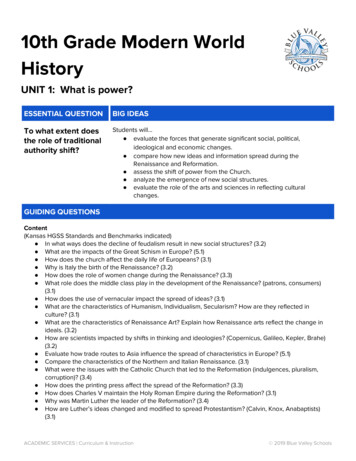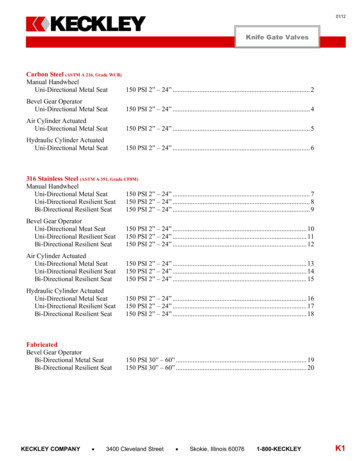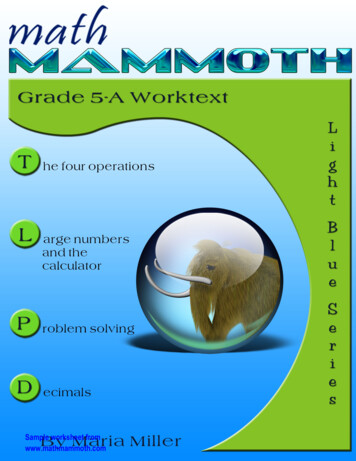
Transcription
6 GradeHistoryReviewthName:Date:Period:
Table of ContentsEarly Humans.page 3Mesopotamia, Egypt, and Kush.page 5Ancient Hebrews.page 7Ancient Greece.page 9Ancient India.page 11Ancient China.page 13Ancient Rome.page15Glossary.page17Review StrategiesLevels of Reading1. First, read through the passage quickly to get the gist. Mark up your text with symbols: I know this already.! Wow! That’s new information!? Huh? I don’t understand this.2. Compare your marks with your study partners. See if they can help you understandparts of the text you don’t understand.3. Now, take a little more time. Read the questions in the margins. Highlight the parts ofthe text that contain answers to the questions. Be sure you are getting all of theinformation that answers each question.Vocabulary Selective Highlighting1. As you read the text, use a highlighter to highlight the vocabulary words that appear inbold print, as follows:Blue I pretty much know what this word means.Yellow Okay, I don’t have a clue what this word means.Remember: You already know a lot!! This is all about reviewing what you might have forgotten.2
DEVELOPMENT OF HUMANKINDBig Idea: Based on the work of anthropologists, paleontologists, and archeologists, wecan reconstruct the development of humans from hunter-gatherer societies to settledcommunities. Early human communities populated Africa, Europe, and Asia, and later migratedto Australia and North and South America, adapting to the diverse environments found in eachlocation.Time Frame: 3 Million BCE - 3000 BCEWhere in the World?QuestionsTextEarly HumansWhat were some of thedevelopments leading tomodern humans?Some of the developmentsleading to modern humanswere.How did early modernhumans adapt to theirenvironment?Early humans were able toadapt to their environmentby.Based on the work of anthropologists, archeologists, and paleontologists,historians have been able to reconstruct the mysteries of prehistoric humans. In1974, Donald Johanson discovered evidence of early hominids such asAustralopithecus afarensis (“Lucy”) living in Africa about 3 to 4 million years ago.They were bipeds, meaning they walked on two feet. Louis and Mary Leakey foundevidence of hominids in Africa who used early tools and who lived about 1.5 to 2million years ago. They called these hominids Homo habilis, or “Handy Man.” In1891, Eugene Dubois discovered the bones of a group of hominids who lived in Asia1.8 million to 200,000 BCE. He called this group Homo erectus, or “Upright Man.”This group of hominids is notable for more advanced tools and being able to use fireto cook meat.Prehistoric humans, known as Homo sapiens sapiens, or “Doubly Wise Man,”originated in Africa and spread to Europe, Asia, and Australia between 35,000 to12,000 BCE. Eventually, they migrated to North and South America. The firsthumans looked more like us. They were able to survive in cold climates throughadaptation, their ability to create better tools, shelter, and clothing. These earlyhumans also created artwork, including cave paintings, carved images of clay, bone,and ivory, and even musical instruments.3
From Old Stone Age to New Stone AgeWhat are some keydifferences between theOld Stone Age and NewStone Age?Some differences betweenthe Old Stone Age and NewStone Age are.The Old Stone (Paleolithic) Age began about 2 million years ago and lasted untilabout 8000 B.C.E. It was during this time that early modern humans developed. Likethe hominids who came before them, early humans were hunter-gatherers. Theywandered from place to place, looking for animals to hunt and plants to gather forfood. Often they took shelter in caves.The New Stone (Neolithic) Age began when people learned to farm and producetheir own food. The discovery of farming did not happen all at once. Over thousandsof years, people gradually learned to raise animals and plant crops. Eventually theybegan to rely on farms for their food. Many historians call this the agriculturalrevolution. Now they could settle down in one place instead of roaming in search ofthings to eat. The Neolithic Age began around 8000 B.C.E. and lasted until about3000 B.C.E., when people learned to make tools out of metal instead of stone.Farming and the domestication of animals developed in many parts of the worldduring this time, including parts of Europe, Africa, Asia, and the Americas.Key ntologist4
MESOPOTAMIA, EGYPT, AND KUSHBig Idea: Settled farming societies located next to major rivers developed into earlycivilizations (Mesopotamia around the Tigris and Euphrates Rivers; Egypt around the Nile River).These early civilizations had highly structured governments that maintained political and socialorder through religious beliefs. They developed writing, refined art and architecture, and lawcodes, such as Hammurabi’s Code.Time Frame: 3000 BCE – 350 CEWhere in the World?QuestionsWhere did earlycivilizations arise? Why?Early civilizations arosearound.because.Describe early city-statesin Mesopotamia.Early city-states inMesopotamia were.TextEarly Civilizations and the EnvironmentEarly civilizations arose in areas whose environmental factors could support largepopulations. The most important factor was water for drinking, bathing, irrigation,and transportation. For this reason, early civilizations arose around rivers. Sinceearly civilizations needed enough food to support large populations, two otherfactors were important: topography and climate. The topography (land surface) hadto be relatively flat to allow for farming, and the climate needed to supportvegetation, or plant life, especially the crops people grew.Mesopotamia (Sumer, Babylonia)The first civilization arose in Mesopotamia (modern-day Iraq) in the areabetween the Tigris River and the Euphrates River. Cities first appeared in thesouthern part of this land, an area called Sumer. These first cities were like small,independent countries, with their own ruler and their own farmland; for this reason,they are called city-states. The Sumerians built complex irrigation systems anddeveloped tools such as the plow that enabled them to increase their food supplythat resulted in a surplus of food to support its population. To defend themselvesfrom attack, Sumerian city-states built walls and dug moats around their cities.Sumerian city-states were ruled by kings. Sumerian kings were priest-kings, andthe Sumerians believed that their kings were chosen by the gods. This belief madetheir kings very powerful, since Sumerians believed they must obey the will of thegods. A Mesopotamian city-state called Babylon united all of Mesopotamia under5
Who was Hammurabi?Why is he important?Hammurabi was.He is important because.What were some of theachievements of theancient Egyptians?Some of the achievements ofthe ancient Egyptians were.What did the Egyptiansbelieve about theirpharaohs?The Egyptians believedthat.What was Kush?Kush was.the rule of Hammurabi, the king of Babylon. Hammurabi is best known for hisdetailed legal code, which covered many situations, such as trade, payment for work,marriage and divorce. Hammurabi used the code of laws to unify his empire and topreserve order.The Sumerians created a written language called cuneiform around 2400 BCE. Itwas used to record information about the goods Sumerians exchanged with eachother, and later for literature.EgyptThe Nile River valley provided Egypt with an environment in which crops andcities could flourish. Ancient Egypt enjoyed three long periods of stability and unityunder the rule of pharaohs. The Old Kingdom lasted from about 2700 to 2200 B.C.E.During this time, early pharaohs set up a strong central government. Some pharaohs,like Khufu, built great pyramids as tombs for themselves. During the Middle Kingdom(about 2000 to 1800 B.C.E.), Egyptians made many great achievements in literature,art, and architecture. The New Kingdom (about 1600 to 1100 B.C.E.) is often calledEgypt's Golden Age. During this time of peace and stability, Egypt's power reached itsheight. Hatshepsut, Egypt’s first female pharaoh, supported Egyptian trade. Ramsesthe Great was a superior military leader and built gigantic monuments.As in Mesopotamia, religion played a central role in Egypt's social and politicalorder. The pharaohs were believed to be gods. They owned all the land and wereresponsible for the people's well-being. During their lifetimes, they built massivetemples dedicated to the gods and other monuments to glorify their power andsuccess. After they died, they were buried in great tombs that were built to lastforever.Like the Sumerians, Egypt developed its own writing system, called hieroglyphicwriting. Hieroglyphic writing uses pictures called hieroglyphs to represent soundsand ideas. The Egyptians used hieroglyphic writing to record their history, keeprecords, and write literature.KushThe Kushite civilization settled to the south of Egypt, along the southern part ofthe Nile. Their civilization began around 2000 BCE and lasted until 350 CE. Egypt andKush had close ties for centuries. Each country invaded and conquered the other.Kushite pharaohs ruled Egypt for nearly a century, and modeled the art andarchitecture of their own civilization after Egypt.Key eenvironmentGRAPEShieroglyphirrigationlegal codepharaohpriest-kingsurplus6
THE HEBREWSBig Idea: The Hebrews originated the world’s first monotheistic religion based on theidea of one God who gives laws regarding proper behavior. The teachings and beliefs of Judaisminfluenced Western Civilization in the areas of religious belief, observance of law, and ideasabout right and wrong. In spite of the dispersion of the Jewish population from Jerusalem after70 CE, Judaism survives to the present day.Time Frame: 1800 BCE – 70 CEWhere in the World?QuestionsHow did the ancientHebrews developJudaism?The ancient Hebrewsdeveloped Judaism.TextThe Ancient Hebrews and the Origins of JudaismThe Hebrew civilization developed gradually after 1800 B.C.E. and flourished until70 C.E. The people who became the Hebrews originally lived in Mesopotamia.Around 1950 B.C.E., they moved to the land of Canaan (modern-day Israel). TheHebrews were the founders of Judaism, one of the world's major religions. TheHebrews eventually became known as the Jews. Judaism is the Jewish religion. Theorigins of Judaism and its basic laws are recorded in its most sacred text, the Torah.The word Torah means "God's teaching." The Torah consists of the first five books ofthe Hebrew Bible. (Christians refer to the Hebrew Bible as the Old Testament.)Historians rely on many artifacts to learn about the ancient Hebrews and theirtime, including the Torah. According to the Torah, the ancestor of the Hebrews, aman named Abraham, lived near Ur in Mesopotamia. Around 1950 B.C.E., Abrahamand his clan migrated to the land of Canaan. Settling in Canaan, the Hebrews herdedflocks of sheep and goats. About 1800 B.C.E., many Hebrews moved to Egypt.According to the first book of the Torah, they fled Canaan because of a famine. For atime they prospered in Egypt, but eventually they were made slaves. In time, one oftheir leaders, Moses, led the Hebrews in their escape from Egypt. For 40 years, saysthe Torah, the Hebrews wandered in the wilderness, until they settled once again inCanaan. By 1000 B.C.E., the Hebrews had set up the kingdom of Israel in Canaanunder King David and his son, King Solomon. David forged the Hebrews into oneunited nation. Solomon built a magnificent temple in the capital city of Jerusalem.7
How did Judaisminfluence Westerncivilization?Some of the influences ofJudaism on WesternCivilization are.How did Judaism manageto survive into the presentday?Judaism was able to surviveinto the present daybecause.The Influence of JudaismThe religious and moral ideas of Judaism have left a lasting mark on Westerncivilization. Three important beliefs and practices still influence us today:monotheism; following the law; and concepts of equality and justice.Monotheism: Most people in ancient times believed in many gods. The Hebrewswere different. They believed that there is only one God, a belief called monotheism.Judaism teaches that God is all-powerful and all-knowing. God is also the source ofmorality (standards of right and wrong).Following the Law: Judaism's oldest laws are the Ten Commandments. Thecommandments tell how to honor God. The commandments also lay down morallaws of ethics (right and wrong), such as "You shall not steal” and "You shall notmurder." Many Western countries adopted these laws of right and wrong.Equality and Social Justice: Unlike some other ancient peoples, the Hebrews didnot view their leaders as gods. They believed that there is only one God, and evenkings had to obey God's laws. Judaism teaches that all people who keep the laws areequal in God's sight. Belief in equality goes hand in hand with a concern for socialjustice. Caring for the less fortunate people in society is a basic value in Judaism.The Survival of JudaismThe Hebrew kingdom split in two after the death of King Solomon. Weakened bythis division, the Hebrews were less able to fight off invaders. In 586 B.C.E.,Nebuchadrezzar burned down Solomon's great Temple of Jerusalem and all thehouses in the city. Most of the people of Judah were taken as captives to Babylon.The captivity in Babylon was the beginning of the Jewish Diaspora. The worddiaspora means "a scattering." Never again would most of the followers of Judaismbe together in a single homeland.Later, the Jews living in Judah were conquered by the Romans. In 66 CE, the Jewsrose up in rebellion against the Romans. In 70 CE, the Romans led an army againstthe Jews. The Romans destroyed Jerusalem and its great temple.Despite having lost their homeland and holy city, Judaism survived through theformation of synagogues and the tradition of allowing any adult male to read fromthe Torah. Jews no longer needed a trained leader to learn about Jewish history andlaw. These new practices helped Jews preserve their religion in communities aroundthe world.Key ral lawsynagogueTorah8
ANCIENT GREECEBig Idea: The ancient Greeks developed a vibrant civilization in the region of the AegeanSea. Early democratic forms of government developed, especially in the city-state of Athens.Alexander the Great spread Greek culture through much of the ancient world. Theachievements of the Greeks in the fields of literature, arts, and sciences, influence us today.Time Frame: 800 BCE – 320 BCEWhere in the World?QuestionsHow did the Greekcivilization develop?Greek civilizationdeveloped.TextDevelopment of Greek CivilizationThe Greeks settled first in isolated communities because of their country’s mountainousgeography. Most Greeks survived by farming, but good farmland was scarce. So the Greekstook to the seas, creating new colonies and trading with other peoples.Athens and the Rise of DemocracyHow did democracydevelop in Athens?Democracy in Athensdeveloped.How is Greek democracydifferent from today’sdemocracy?The ancient Greeks knew they had many things in common and had a unified culture. Forexample, they all spoke the same language. But they did not think of themselves as onecountry. Instead, every Greek identified with a hometown that he or she called "the city." Thecity included both a settlement and its surrounding farmland. Most Greeks were fiercelyproud of their cities. Each city had its own laws, its own army, and its own money. Mostimportant, each city had its own form of government. For this reason, ancient Greek cities arecalled city-states.Four forms of government that developed in the Greek city-states: monarchy, oligarchy,tyranny, and democracy. Unhappiness with one form of rule led the Greeks to try another.Early monarchies (governments led by a king), gave way to oligarchies (government by a few).In turn, many oligarchies were replaced by tyrannies (government where one person takespower by force). Eventually, Athens developed a democracy or “rule by the people,” agovernment where all citizens shared in the ruling power.Ancient Greek democracy was different from democracy today. The government ofAthens was a direct democracy. In this type of government, every citizen can vote on every9
Greek democracy is differentfrom today’s democracybecause.issue. Unlike Athens, the United States is a representative democracy. In this type ofgovernment, people vote for representatives who decide issues in their name.Athens and SpartaHow were Athens andSparta alike? Different?Some ways Athens andSparta were alike are.Some ways Athens andSparta were different are.What were the roles ofAthens and Sparta in thePersian War? In thePeloponnesian War?In the Persian War, Athensand Sparta.In the Peloponnesian War,Athens and Sparta were.What were some of theaccomplishments ofAlexander the Great?Some of theaccomplishments ofAlexander the Great were.What are some of theimportant contributionsof the Greeks?Some of the contributions ofthe Greeks are.Athens and Sparta were two very different city-states in ancient Greece. Athens was ademocracy, though only free men could take part in its government. Its economy dependedon trade. Boys were educated to be good citizens. Girls learned skills for managing thehousehold. Women and slaves had far fewer rights than men had. Sparta was more isolatedthan Athens. It was primarily a military state. Its government was an oligarchy in which a fewmen held most of the power. The Spartan economy depended on farming and conquest. Boysand girls alike were educated to protect the city-state. Spartan women had more rights thanother Greek women. The city depended on slaves and other non-citizens to provide for manyof its needs.Athens and Sparta were bitter rivals. However, they came together with other Greek citystates to defeat the Persian Empire, which threatened to take over Greece. With the defeatof the Persians, Athens became the dominant city-state in Greece. Later, Athens and Spartafought each other in the Peloponnesian War. Sparta defeated Athens in this war, and Athenslost its dominance.Alexander the GreatAlexander the Great became king of Macedonia after his father’s murder. By that time,Macedonia already controlled most of Greece. As skilled general, Alexander conquered a vastempire that spanned much of Asia as well as Egypt. To unify this huge territory, he spreadGreek ideas, used religion, and showed respect for the cultures of the people he conquered.Alexander’s empire soon died, but Greek ideas lived on.Contributions of the GreeksThe Greeks made many important contributions to Western civilization. For example,Hypatia was the first woman to earn fame as a mathematician, teaching Greek philosophyand mathematics in the city of Alexandria. Euclid was another famous Greek mathematician.His geometry textbook became the basis for the teaching of geometry for more than 2,000years.The Greeks also produced famous philosophers. Socrates was always encouraging peopleto question the things they thought they knew. He taught others by asking questions thatforced them to think about their beliefs. His example inspired many other Greek thinkers,especially his student Plato. Plato taught these same ideas to Aristotle, who was the teacherof Alexander the Great.Greek literature influences us today. The mythology of the Greeks, Greek epic poetrysuch as Homer’s Iliad and Odyssey, even Aesop’s Fables are stories we still read today.Historians today follow in the footsteps of Thucydides, considered one of the greatesthistorians of the ancient world, who wrote about the wars between Athens and Sparta.Key rect resentative democracytyranny10
ANCIENT INDIABig Idea: Early civilizations arose in India along fertile rivers. They developed anelaborate social structure known as the caste system, which divided society into several levels.Early belief systems, such as Buddhism, developed in India and spread beyond its borders. Theearly civilizations of India developed impressive cultural achievements in literature, science, andmathematics.Time Frame: 2700 BCE – 550 CEWhere in the World?QuestionsWhere did the earlycivilizations of Indiadevelop?Early civilizations of Indiadeveloped.What was the castesystem? How did itdevelop in India?The caste system was.It developed in India.TextEarly Civilizations in IndiaLike many ancient peoples, the first people in India settled by rivers, such as theIndus River and the ancient Sarasvati River. The rivers provided plenty of water. Thefertile soil was ideal for farming. The rivers could also be used for travel and trade.Soon, a vibrant civilization arose in such cities as Mohenjodaro, which was a largeand well-planned city with a high quality of life.Hinduism and the Caste SystemHinduism was India’s first major religion. It teaches concepts such as dharma(law, obligation, and duty), deities (multiple gods), samsara (reincarnation) andkarma (what we do in this life affects future lives). It developed over a long time,perhaps being brought into India by Aryan invaders. Early Hindu religion is calledVedism, after sacred texts. A class of priests and religious scholars, called Brahmins,became important because only they knew how to interpret the Vedas and performthe rituals. Brahmins became the dominant class in India. Later Vedism is known asBrahmanism.Brahmanism taught that a well-organized society was divided into social classes.Europeans later called this the caste system. Each social class had its own duties.Brahmins were the highest caste; untouchables were the lowest. Indians were borninto a certain caste, and they could not change it. People could marry only withintheir own caste.11
Who was the Buddha?What did he teach?The Buddha was.He taught.How did Buddhism spreadto other parts of Asia?Buddhism spread to otherparts of Asia by.What were some of theachievements of ancientIndia?Some of the achievements ofancient India were.BuddhismBuddhism is another great religion that began in India. Buddhism is based on theteachings of the Buddha, which means “Awakened One.” The Buddha was a manwho lived in India from about 563 to 483 BCE. Before earning the title of Buddha, hewas a young prince named Siddhartha Gautama. At the age of 29. Prince Siddharthawalked away from his royal life and went in search of spiritual peace. During his journeys, he learned great truths that changed his life, By sharing these truths withothers, he began the great religion of Buddhism.Buddhism was different from Hinduism in several ways. It was not based on complicated rituals and beliefs in many gods, as Hinduism was. Instead, it was a way oflife based on simple teachings. Unlike ancient Hinduism, Buddhism embraced allpeople regardless of their caste. It taught people how to reach enlightenment, orhappiness that comes from the knowledge of deep truth, as embodied in the FourNoble Truths (life in suffering; suffering is caused by desires; the way to end sufferingis to give up desires; to give up desires one must live a moral and focused life).Buddhists believed that once they reached enlightenment, they would no longer bereborn again and again. The Buddha chose to teach others the path that he hadfound. In time, his followers spread his teachings throughout India and other partsof Asia.Later, India was unified for the first time under the Mauryan Empire. TheMauryas created their empire through a series of wars and conquests. This changedwhen King Ashoka turned away from violence. Ashoka adopted Buddhist values. Hepromoted Buddhism, justice, and security.Achievements of Ancient IndiaIndia reached its Golden Age during the time of the Gupta Empire. The Guptasencouraged learning by building universities. Writing, painting, sculpture, andmetalwork flourished. For example, Gupta writers created many kinds of literaryworks. The Bhagavad Gita (“Song of the Lord”) is one of the most beautiful works ofHinduism. In this poem, a prince is taught basic truths of Hinduism by Krishna, anearly form of the deity Vishnu. Gupta mathematicians also made importantadvances, such as place value, the decimal system, and the concept of zero. Many ofthese achievements, especially in mathematics and literature, continue to affect theworld today.Key VocabularyBrahmanismBuddhismcaste systemempirefertilegolden ageGRAPESHinduisminvadersocial class12
ANCIENT CHINABig Idea: As in other parts of the world, early civilization developed in China around theHuang-He river valley. During a turbulent period, the philosopher Confucius taught peace andorder could be achieved through proper behavior. Qin Shihuangdi unified China and became itsfirst emperor. During the Han Dynasty, China developed a strong centralized government.China became wealthy through trade along the Silk Road.Time Frame: 1700 BCE – 220 CEWhere in the World?QuestionsWhat were some keyachievements of theShang Dynasty?Some key achievements ofthe Shang Dynasty were.Why did Confucianismand Daoism develop?What are their keyteachings?Confucianism and Daoismdeveloped because.Some of the key teachings ofConfucianism are.Some of the key teachings ofDaoism are.TextOrigins of Chinese CivilizationOne of China's earliest dynasties was the Shang dynasty. Shang kings werepowerful rulers who kept their power through military might. The Shang practicedancestor worship and, sometimes, human sacrifice. Their writing used logographs aswell as pictographs. Shang craftspeople excelled in working with bronze and jade.The Shang ruled in the valley of the Huang He for some 500 years. It was followed bythe Zhou Dynasty.Confucianism and DaoismDuring the Zhou Dynasty, three Chinese philosophies developed: Confucianism,Daoism, and Legalism. During the Zhou Dynasty's later years, China collapsed intodisorder. Political instability led many scholars to debate the proper way to rule.Confucius taught that peace and order depended upon proper behavior. Those inauthority must lead by example. Those below them must obey. Daoists believed thatpeople should live simply and in harmony with nature. They said the best rulers werethose who ruled the least. Finally, Legalists like Hanfeizi believed that people weredriven by their own self-interest. They taught that rulers could create order onlythrough strict laws and harsh punishments.13
Qin and Han DynastiesWhat were some of theaccomplishments of QinShihuangdi?Some of theaccomplishments of QinShihuangdi were.What are some of theaccomplishments of theHan Dynasty?Some of theaccomplishments of the HanDynasty were.What was the Silk Road?What goods and ideaswere traded along the SilkRoad?The Silk Road was.Some goods and ideas thatwere traded were.Qin Shihuangdi was China's first emperor. The Emperor of Qin had a majorinfluence on China. He unified China and greatly expanded its borders. He centralizedthe government. He standardized Chinese laws, money, weights, measures, andwriting. Among his many construction projects was the Great Wall. Later Chineserulers built on what the Emperor of Qin left behind, including governmentinstitutions and the Great Wall itself. The office of emperor that he created lasted for2,000 years. Even China's name in the western world comes from the word Qin. Butthe harshness of the Emperor of Qin's rule led to an early end for his dynasty.The Han Dynasty ruled China for more than 400 years. Most of this period was atime of peace, wealth, and achievement for China. Under the Han, the Chinese madeadvances in many areas. New weapons helped Han emperors succeed in war andexpand their empire. The government was organized into a bureaucracy staffed bycivil servants who were chosen for their ability. A number of inventions improvedagriculture and the important silk and salt industries. The invention of paperadvanced the art of calligraphy. Healers used techniques and practices that are stillused today. Finally, Chinese scientists made important observations and invented theseismograph and the compass.The Silk RoadThe Silk Road was a network of trade routes between China and the West(Europe). The Silk Road was opened under the Han and remained a major route oftrade for more than 1,000 years. Many goods were exchanged along the Silk Road,including silk from China and glassware from Rome. In addition to new products,trade brought cultural diffusion and change to both East and West. One of the mostimportant changes was the introduction of Buddhism to China.Key nastyemperorempireGRAPESSilk Road14
ANCIENT ROMEBig Idea: The Roman civilization first developed on the Italian peninsula. The Romansdeveloped a republican form of government that later transitioned to an empire underAugustus, which expanded to cover most of the Mediterranean world. After years ofpersecution, Christianity eventually became the state religion. Roman art, architecture,technology, literature, language, and law influence us today.Time Frame: 753 BCE – 476 CEWhere in the World?QuestionsHow did Rome begin?Rome began.What were some keyfeatures of Romangovernment during theRepublic?Some key features of Romangovernment during theRepublic were.TextThe Beginnings of RomeAccording to mythology, Romulus founded and named the city of Rome after thedeath of his twin brother Remus. Supposedly
Hebrews were the founders of Judaism, one of the world's major religions. The Hebrews eventually became known as the Jews. Judaism is the Jewish religion. The origins of Judaism and its basic laws are recorded in its most sacred text, the Torah. The word Torah means "God's teaching." The To











